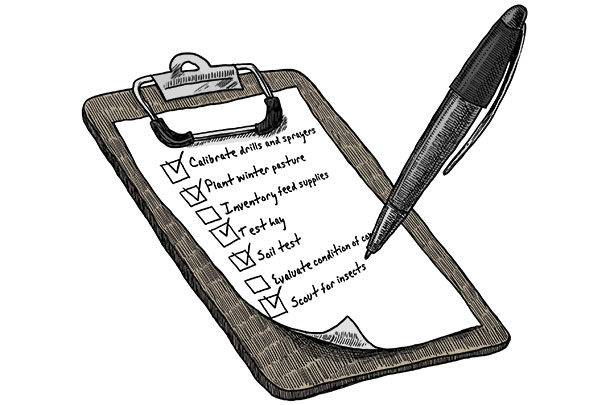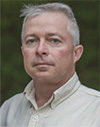Since the article release date is September, I’m forced to do something progressive forage producers must also be doing: think forward.
So what should I be doing as a forage producer in September?
In the Southeast, it is time to plant winter pasture (cool-season annual cereal grasses) for stocker cattle grazing and perhaps for winter supplementation to the cow herd. To maximize our forage production and grazing days, we like to get it planted by Sept. 15.
So, I should already have my seed variety identified, germination test and seedling vigor tested if needed. Soil testing should be done, and I should have identified nutrient deficiencies and how I am going to correct them. I need to get my planting equipment ready and calibrated.
It’s important to calibrate every time planting equipment enters the field. It can be a chore, but conditions change every year, test weights vary, and seed counts vary year to year. Also, planting equipment changes year to year and season to season.
I recently calibrated a drill and found seed pouring out of a seed cup that had been perfectly fine when we parked the drill the previous season. If no-tilling, calibrate the sprayer and line up burndown chemical. If clean-tilling, make sure tillage equipment is good to go.
Looking forward, what else should I do? In the Northern Hemisphere, most growers are approaching the end of the active forage growing season for warm-season perennials and annuals, but it is just starting for cool-season annuals and perennials. As frost is approaching, I need to be thinking forward about getting my warm-season perennials ready for winter.
Late summer and early fall prior to frost, warm-season perennial forages are translocating nutrients from aboveground growth to below-ground storage that will be used for growth in the spring. Controlling grazing intensity this time of the year is just as important for persistence as any other time of the year.
Keep in mind: Once these warm-season perennials go dormant, I can graze them again but still be mindful of not grazing them too close. I don’t want to open them up to weed pressure in the spring.
In September, I am also taking inventories. What livestock and how many do I have? What are their nutritional needs now and to the spring? What standing forages do I have on hand? How much, and what is the quality? What can I graze now, and what can I defer until later?
How much hay do I have on hand, and is it tested? How old is the hay, and how well has it been stored? Round-bale hay more than a year old and stored outside will probably have rotted wrap, and when you pick it up, as much as half of that bale may stay on the ground. That is something to think about, especially if you have 100 bales stored in a row; effectively, you may only have 50.
Another thing I have to do and think about is insect scouting. In regions of the country where winter pasture is grown, I need to be aware armyworms occur every year somewhere. I need to be on the lookout for them and be prepared if populations meet the economic threshold for control.
I also want to be aware of aphids, grasshoppers, mites and cutworms. I also have to think about what beneficial predatory insects are available and whether they can keep damaging insects in check. There are several extension publications on the beneficial insects, how to scout for them and assessing their impact.
While we should be thinking forward in September, we also need to take a look back at the nearly completed growing season. Evaluate your perennial forage base and your production year. What issues developed during the year that will still be present at spring green-up? What kind of a response did you get from your weed control and fertilizer? Was it better or worse than expected? Determine why either of those effects occurred.
Take the information from that look back, then project it forward. How are you going to address problems that came up this year for the next growing season? This is especially important if you need to renovate existing forages or establish new ones.
Rainfall is the driver of all things green. There’s not a thing we can do to make it rain when we want, but we can think forward on the rainfall we get in September and consider how it will influence fall and winter forage production. I like to think about September and fall rains and, as a result of those rains, what I can expect in the spring.
Fall rains for us here in our part of the Southern Great Plains generally means good spring ryegrass production as well as spring legumes, such as arrowleaf clover. If the fall is dry, it is going to affect stockpiled forage production, which may mean filling the forage gap in other ways or feeding later into the spring than I may want to. I need to be prepared to make adjustments based on the conditions present.
What do I have to do in September? Get ready for winter pasture establishment, calibrate drills and sprayers, line up fertilizer for annual winter pasture, plant winter pasture, scout for insects, do a perennial forage inventory, inventory feed supplies, test hay if I have not yet done so, soil test, evaluate the condition of my cow herd, get my warm-season perennial grasses ready for winter dormancy, think about rainfall and its impact on forage production in the coming months and how I can make adjustments in accordance with rainfall, look back and learn from the previous growing season and – oh yeah, find out what everyone wants for Christmas.
I better get started. ![]()
ILLUSTRATION: Illustration by Kristen Phillips.

-
James Rogers
- Assistant Professor
- Noble Research Institute
- Email James Rogers









